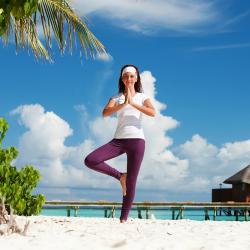

How often are we good at something the first time we try it? The first time I went snowboarding, I slid down the bunny hill on my bottom. But I got up and tried again. Yoga is a practice. You can’t expect to be “good” on the first day. As you continue to practice, your body gains strength and flexibility.
With so many yoga styles and classes available in most cities, I often recommend that yoga newbies try a few different styles of yoga. Choosing the best yoga for your body and your fitness personality is integral to enjoying your yoga experience and receiving the benefits of your practice. Here is a breakdown of some common types of yoga and the people they might appeal to:
Ashtanga: Considered a form of Power Yoga by many, Ashtanga classes are not for the faint of heart. These faster-paced classes offer a vigorous, not-stop series of poses. If you like order or routine, Ashtanga classes offer the same series of poses in the same order each time. Try Ashtanga if you are physically fit or have experience with other types of yoga.
Bikram: Do you like to sweat? This is the class for you! This sequence of 26 Hatha yoga postures and 2 breathing exercises is performed in a room heated to over 105 degrees. The high heat and intense sweating lets your muscles get a deeper stretch and allows your body to flush out toxins.
Hatha: Hatha yoga is the most common form of yoga taught in the United States. It is great for yoga newbies, as classes focus on breathing and holding poses. Hatha classes are a fantastic opportunity to learn a few basic poses.
Iyengar: This slow-paced class focuses heavily on the correct alignment of each posture and can be great for beginners. Often, props, such as belts and blocks, are used to help students get into poses with correct alignment. This can be particularly helpful for practitioners who are new, injured or particularly stiff.
Vinyasa: Commonly called Vinyasa Flow, this class will keep you moving rather than finding stillness in postures, so don’t be surprised if you break a sweat. Expect a fully choreographed routine and a different class each time. Most teachers play music to keep classes going.
Restorative: Don’t expect a calorie-burning workout in this class. Restorative yoga poses are gentle stretches, held for longer periods of time. Props, such as belts, straps, blocks and blankets are often used. This is a good class if you are injured, very overweight, or have limited mobility.
Many yoga studios or gyms offer reduced rates to new students, so try a few different types classes with a few different teachers. Many teachers incorporate their own style or music choices into classes. Choose the one that best suits your body and your lifestyle.
(yoga / shutterstock)